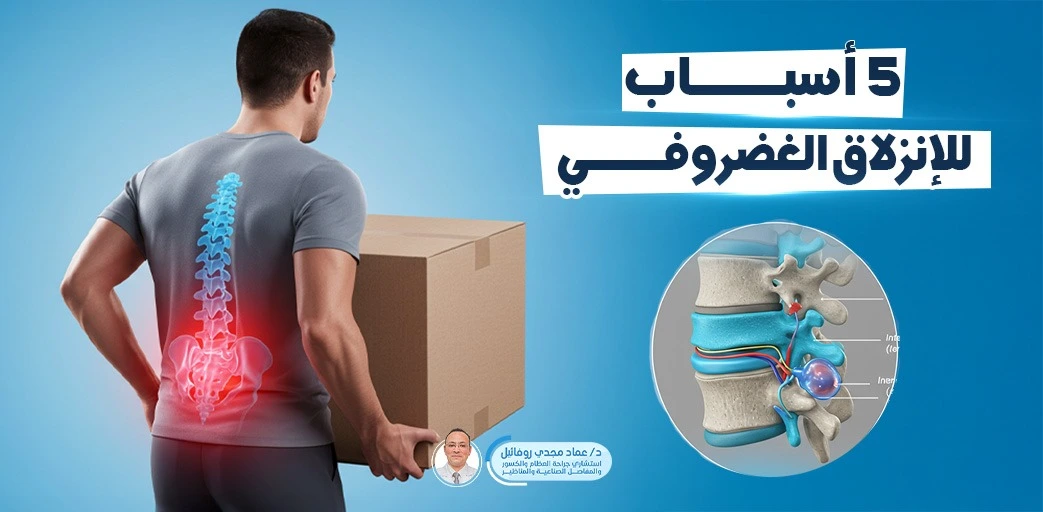


If you're looking to take control of your health and well-being, scheduling a medical appointment is a great first step. Whether it's a routine check-up, a specialist consultation, or a follow-up appointment with your healthcare provider, it's important to prioritize your health and take the time to address any concerns or questions you may have.


Dr. Emad Roufail emphasizes the importance of understanding the causes of herniated discs to protect the spine from damage and avoid chronic pain.
Ignoring poor posture or lifting heavy objects incorrectly are among the most common causes faced by many patients. He urges people to fully understand these causes, as prevention is far easier than going through treatment later on.
In this article, we’ll cover all the common and rare causes of herniated discs, along with practical tips to protect your back and daily lifestyle.
Many people lift heavy objects by bending the back instead of squatting with the knees, which puts direct pressure on the disc, causing its outer wall to tear and the jelly-like center to push out and compress nearby nerves.
Office jobs often require long hours of sitting, especially with a forward-slouching back, which puts repetitive stress on spinal discs and makes them more prone to damage.
As we age, disc hydration decreases, making them drier and more fragile. This reduces their shock-absorbing ability and increases the risk of herniation.
When the core and back muscles are weak, the body cannot properly distribute weight. As a result, the spinal disc bears excessive load, increasing the chance of slipping.
Obesity puts extra pressure on the spine, especially the lower back, increasing stress on discs and contributing to herniation.
Jumping, twisting, or moving suddenly without warming up can cause instant pressure on a disc, leading to a tear and immediate herniation.
Some studies suggest that disc structure weakness may be inherited, making certain families more prone to herniated discs.
Car crashes or falls from height can cause spinal trauma, leading to sudden disc rupture.
Chronic conditions like rheumatoid arthritis or ankylosing spondylitis can weaken discs and increase the risk of herniation over time.
Rare cases of bacterial or viral infections can damage the disc, weaken its structure, and result in herniation.
Some benign or malignant tumors can press on the spine or destabilize it, increasing disc pressure and the risk of herniation.
Symptoms vary depending on disc location and nerve compression, but the most common include:
Back or neck pain – worsens with movement or prolonged sitting
Radiating pain – to legs (sciatica) or arms/shoulders depending on disc location
Tingling or numbness – due to nerve pressure in legs or arms
Muscle weakness – difficulty gripping objects or climbing stairs
Movement difficulty – daily activities become harder due to pain or fear of worsening it
Loss of bladder or bowel control – indicates cauda equina syndrome, a surgical emergency
Severe, sudden weakness in legs or arms – may signal serious nerve compression
Numbness in the genital area or inner thighs – a red flag for critical nerve involvement
Unbearable pain that doesn’t respond to medication – impacts sleep or daily function
If any of these signs appear, seek medical help immediately, as delaying treatment could result in permanent damage or partial paralysis.
Learn to lift with your knees bent and back straight. Distribute weight evenly or ask for help when needed.
Use an ergonomic chair and take short movement breaks every 30 minutes to reduce disc pressure.
Engage in simple strengthening exercises and eat foods rich in calcium and vitamin D to support spinal health.
Commit to regular exercises that strengthen your core. Consult a physical therapist when needed.
Follow a healthy diet with regular activity to ease spinal pressure.
Warm up before any effort and avoid sudden, jerky movements whenever possible.
Monitor your back health with regular checkups, strengthen your muscles, and protect your spine.
Always use safety gear and seek medical attention after any trauma, even without immediate pain.
Follow your rheumatologist’s treatment plan and maintain light joint exercises.
Take prescribed antibiotics and rest until the infection and pain subside completely.
Diagnose early through imaging and follow your oncologist’s or orthopedic surgeon’s treatment protocol.
In most cases, herniated discs can be managed conservatively with medications and physical therapy. However, some signs indicate a medical emergency, including:
Loss of bladder/bowel control – urgent surgery is required for cauda equina syndrome
Sudden and severe limb weakness – may indicate nerve damage
Complete numbness in the genital area – highly dangerous neurological sign
Uncontrollable pain despite medications – significantly impacts sleep and daily life
In these cases, see your doctor immediately to avoid irreversible complications.
(Details not listed in original text — assumed continuation from previous sections)
Dr. Emad Roufail stresses that awareness and caution about herniated disc causes can save patients from long periods of pain and treatment.
Avoid poor posture and habits, work on strengthening your back muscles, and stick to healthy daily movement to minimize your risk.
And remember, consulting a spine specialist at the first sign of symptoms is the best step toward prevention and avoiding serious complications.